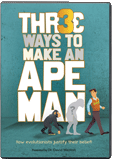
Neaderthals Prove Technical Capabilities in Jersey Caves
Neanderthal technical prowess belies brutish reputation.
News Source
- Livescience: “Neanderthal Survival Story Revealed in Jersey Caves ”
Continuing excavation at La Cotte de St. Brelade on the Channel Island of Jersey is doing more than filling up museums. The ravine has produced over 250,000 stone tools. But it isn’t just the numbers that are impressive but the quality of Neanderthal workmanship.
“Archaeologists have developed new ways of looking at stone tools since La Cotte de St Brelade was excavated in the 1970s,” says Dr. Beccy Scott from the British Museum and the Ancient Human Occupation of Britain project. “We have been using these techniques to look at how Neanderthals were making and using the tools they left at La Cotte.”
Contrary to their reputation as some sort of sub-human brute, Neanderthals displayed a great deal of technological skill in the manufacture of their tools. Dr. Scott adds, “Neanderthals were travelling to Jersey already equipped with good quality flint tools, then reworking them, very, very carefully so as not to waste anything. They were extremely good at recycling.”
The collapsed caves contain ice age sediments and suggest intermittent periods of occupation, possibly related to changing climate conditions. The area was likely linked by land to the European mainland during the Ice Age due to lowered sea levels, so archaeologists hope to find additional submerged sites nearby.
Evolutionists maintain that Neanderthals died out 30,000 years ago. In the light of archaeological and genetic evidence that Neanderthals and “modern humans” coexisted and interbred, their scenarios must allow for an overlap in the human evolutionary tree.
It is unfortunate that the evolutionary scenario long painted Neanderthals as inherently inferior subhumans. The more we learn about them, the more obvious it is that they were simply a widespread group of normal human beings with some distinctive variations. Like the rest of humanity, their ancestors descended from Noah’s family and were among those who God dispersed from Babel. Just as so-called racial groups developed some distinctions when populations became isolated in the post-Flood, post-Babel world, so did the Neanderthals. And like some other people groups over the years, they eventually died out. Neanderthals were not only fully human but evidently were very skilled people coping with the harsh world of the post-Flood Ice Age. Read more about the rehabilitation of the Neanderthal image and their life during the Ice Age at “Neandertal Man—the Changing Picture.”
Further Reading
- Those Enigmatic Neanderthals
- Putting a New Face on Neanderthals
- Recovery of Neandertal mtDNA: An Evaluation
- Modern Humans with Neanderthal History
- One People
- The Trouble with Sequencing
- Are Europeans Neandertal?
For More Information: Get Answers
Remember, if you see a news story that might merit some attention, let us know about it! (Note: if the story originates from the Associated Press, FOX News, MSNBC, the New York Times, or another major national media outlet, we will most likely have already heard about it.) And thanks to all of our readers who have submitted great news tips to us. If you didn’t catch all the latest News to Know, why not take a look to see what you’ve missed?
(Please note that links will take you directly to the source. Answers in Genesis is not responsible for content on the websites to which we refer. For more information, please see our Privacy Policy.)
Recommended Resources

Answers in Genesis is an apologetics ministry, dedicated to helping Christians defend their faith and proclaim the good news of Jesus Christ.
- Customer Service 800.778.3390
- © 2024 Answers in Genesis





